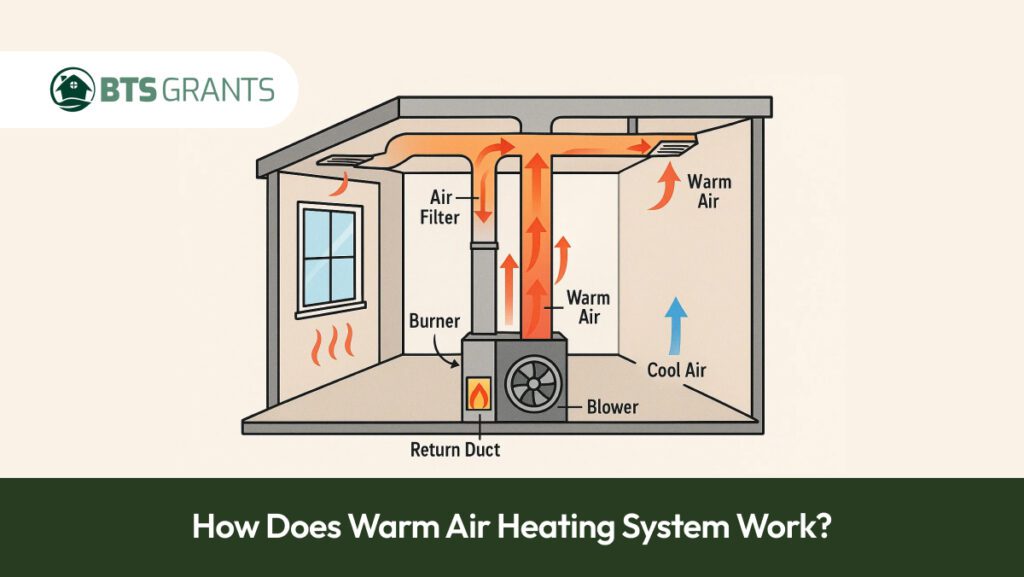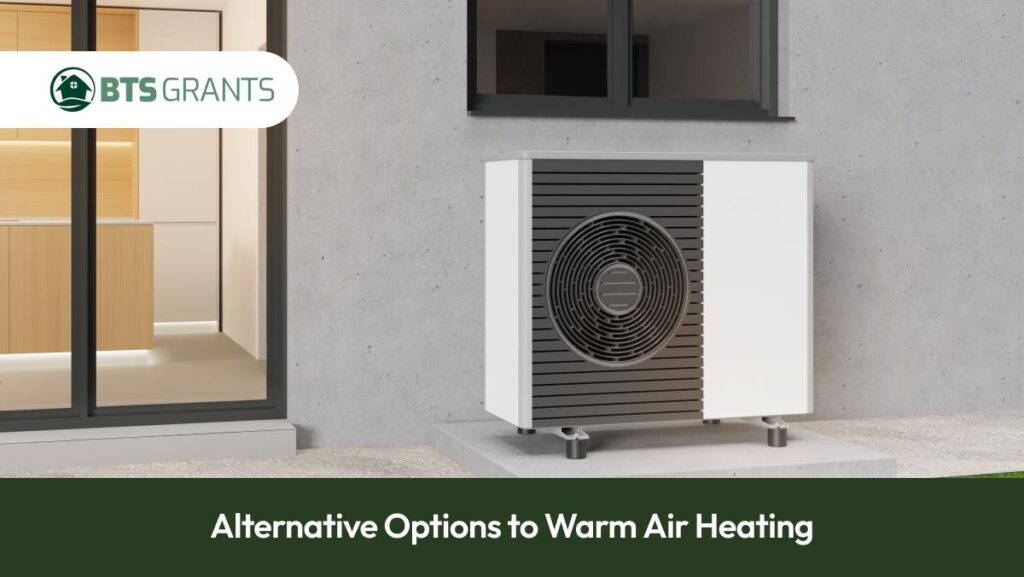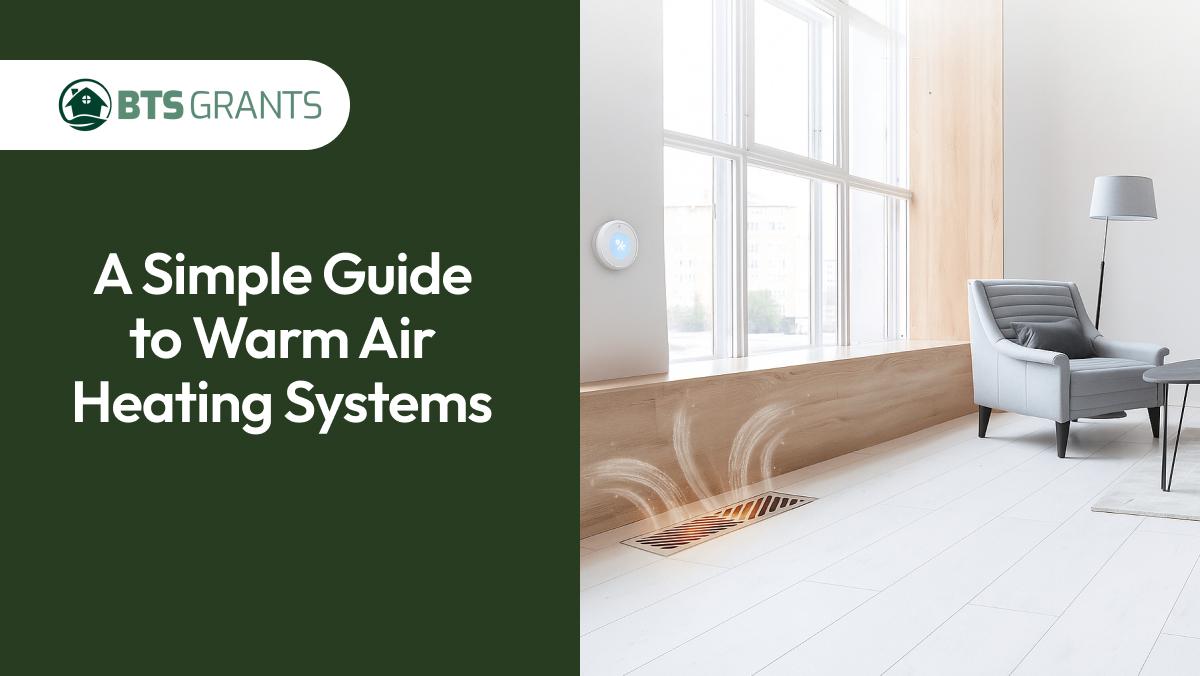Warm air heating systems have been warming UK homes for decades. A one-time favourite of the 1970s, they are experiencing a resurgence with new, energy-saving technology. This guide has everything you need to know about how they operate, their advantages, and what they cost to install as a replacement system.
What Is a Warm Air Heating System?
A warm air heating system, sometimes called a hot air heating system, uses a fan or blower to pull in cool air, heat it through a gas burner or electric coil, and distribute it via ducts and vents. The warm air enters each room evenly, offering a quick and comfortable rise in temperature.
A Look Back: Warm Air Heating in the 1970s
During the 1970s, warm air heating systems were a home favourite throughout the UK. The system worked by blowing hot air through ducts to warm up the house quickly. Many older units are no longer useful and use more energy than they used to. Homeowners with 1970s warm-air heating systems tend to upgrade to newer models to conserve energy and enhance indoor comfort.
The Primary Types of Home Heating Systems
Before examining warm air systems thoroughly, it is helpful to know how they compare to the other types of heating. The four principal systems utilized within UK domestic dwellings are:
- Warm Air Systems – Heat and circulate the air through ducts or vents.
- Wet Central Heating Systems – Employ boilers and radiators to warm water, which heats the house.
- Electric Heating Systems – Includes storage heaters or electric panels.
- Underfloor Heating Systems – Give uniform distribution of heat from underneath the floor.
All the above systems have benefits, but warm air systems are prized for speed and air quality advantages.
Finding the Most Efficient Source of Heat
The best heating system for you will depend on your home, the type of fuel you use, and how you use it. New hot air heating systems can be very efficient. They can use renewable energy or condensing technology. Heat recycling systems that utilize exhaust air or hybrid components offer long-term savings.
What Is Warm Air in Heating Terms?
“Warm air” is air that has been heated by a central unit and then blown through vents. Unlike regular radiators, which heat surfaces, warm air systems heat the air itself. This makes rooms warm up much faster. This also makes them great for homes that need to change the temperature quickly or even spread heat around.
Types of Warm Air Heating Systems
Modern systems are available in several types:
- Gas-Fired Systems – Most popular and most affordable choice.
- Electric Warm Air Systems – Simpler to install and service.
- Renewable or Hybrid Systems – A mixture of warm air technology with solar energy or air source heat pumps.
How Warm Air Heating Systems Work?


Below is a step-by-step process in simple terms:
- Cool air from the house gets sucked into the system.
- The air is drawn through a filter and a heat exchanger.
- A fan pushes hot air through ducts.
- Warm air is discharged through floor or wall vents, heating the house evenly.
Some modern systems also include filters that filter out and improve the indoor air quality.
The Role of Air Pressure in Warm Air Systems
Efficient airflow depends upon a suitable amount of air pressure. Excessive pressure may result in noise or leakages, whereas low pressure may lead to hot spots. A well-balanced system keeps things quiet, keeps the heat even, and saves energy.
Are Warm Air Heating Systems Cost-Effective?
Yes, especially the newer ones. Newer warm air systems are far more energy efficient than their predecessors. They heat homes faster than radiator systems and use less energy. However, regular maintenance is the key to keeping things running smoothly.
Warm Air Heating Systems Replacement Cost
The price of getting a new warm air heating system depends on how big your home is, what kind of system you have, and whether you need new ductwork. In the UK, it costs between £3,000 and £7,000 on average to replace a warm air heating system.
Here’s a summary:
| Type of Warm Air System | Average Cost (Installed) | Key Features | Potential Savings |
| Standard Gas Warm Air System | £3,000 – £4,500 | Inexpensive and easily accessible | Moderate efficiency |
| Modern Gas-Fired Warm Air Unit | £4,000 – £6,000 | Small, quieter, and more efficient | Up to 20% energy savings |
| Electric Warm Air Heating System | £3,500 – £6,500 | Simpler to install, no need for flue | Less maintenance |
| Renewable / Hybrid Warm Air System | £5,000 – £7,000+ | Operates using heat pumps or solar power | Highest long-term savings |
| Replacement via Free Boiler Scheme | From £0 (eligibility required) | Government-funded scheme for low-income households | 100% cost coverage available |
Your 1970s warm air system may be eligible for an upgrade under the ECO4 Grant. The government-funded program assists homeowners in exchanging obsolete systems with new, efficient systems — possibly free, subject to eligibility.
Why Go for Warm Air Heating?
- Rapid heat-up times
- Uniform distribution of heat
- Improved air quality (with filters)
- Low maintenance requirements
It’s a cost-effective, reliable solution for modern homes, particularly those with open-plan living.
Other Alternatives to Warm Air Heating


Although warm air systems work efficiently, homeowners these days prefer others, such as:
- Air Source Heat Pumps – Economical and environmentally friendly.
- Hybrid Systems – Blend conventional heating with sustainable technology.
- Condensing Boilers – The perfect substitutes through the Free Boiler Scheme.
Comparing Heating Options
When choosing a system, compare installation costs, operating costs, and environmental considerations. Warm air systems offer faster heating options compared to traditional boilers, making your home warm more quickly and offering greater convenience than any other method.
Warm Air vs Hot Water Heating
Hot air systems heat and move air directly, while hot water systems heat radiators via pipes. Air systems warm up rooms quickly and produce less pollution, while radiators release steady radiant heat that helps retain warmth for longer.
Heating With Forced Air vs. Radiator
Forced air systems blow hot air through ducts rapidly, warming rooms quickly and usually more effectively. Radiators offer consistent heat but heat up slowly. Which system you opt for depends upon your home’s configuration as well as what level of comfort is desired.
Cost of Operating a Warm Air Heating System
Running costs annually depend on your tariff and the efficiency of your system. A state-of-the-art gas-fired warm air system will cost around £500–£800 per year to operate — about the same as a standard gas boiler installation.
Pros and Cons of Warm Air Heating Systems
Pros
- Rapid and uniform heating
- Cleaner air (with filtration)
- Low maintenance
- Compatible with renewable upgrades
Cons
- Noisy older models
- Installation may involve duct adjustments
- Initial replacement cost
Enhancing Your Warm Air System
- Seal and insulate ducts properly
- Annual servicing should be scheduled
- Filters need to be replaced regularly
- Enhance insulation to minimize heat loss
Conclusion
Warm-air heating systems are still a tried and tested option for UK residents. Whether upgrading an old 1970s warm-air heating system or fitting a fresh hot-air heating system, today’s units provide improved control, efficiency, and air quality. And with assistance from the Free Boiler Scheme, some residents can even upgrade at little or no expense.
FAQ’S
It heats air through a gas burner or electric coil and distributes it via vents for quick, even warmth.
No. Modern systems are efficient and save money on heating bills over older units.
Generally £3,000 to £7,000, depending on your home size and system type.
You could be entitled to a free boiler scheme if you are on particular benefits or are low-income.
It depends on your home. Warm air systems heat up faster and improve air flow. Radiators give off constant radiant heat.



